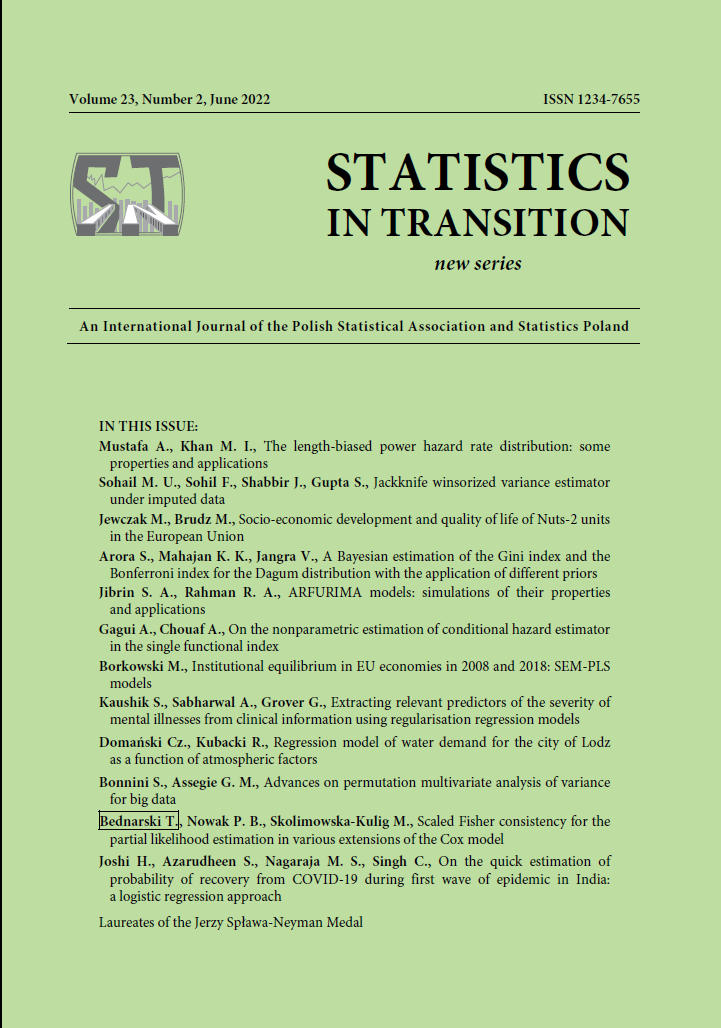© Sangeeta Arora, Kalpana K. Mahajan, Vikas Jangra. Article available under the CC BY-SA 4.0 licence
![]()
ARTICLE
ABSTRACT
Bayesian estimators and highest posterior density credible intervals are obtained for two popular inequality measures, viz. the Gini index and the Bonferroni index in the case of the Dagum distribution. The study considers informative and non-informative priors, i.e. the Mukherjee-Islam prior and the extension of Jeffrey’s prior, respectively, under the presumption of the Linear Exponential (LINEX) loss function. A Monte Carlo simulation study is carried out in order to obtain the relative efficiency of both the Gini and Bonferroni indices while taking into consideration different priors and loss functions. The estimated loss proves lower when using the Mukherjee-Islam prior in comparison to the extension of Jeffrey’s prior and the LINEX loss function outperforms the squared error loss function (SELF) in terms of the estimated loss. Highest posterior density credible intervals are also obtained for both these measures. The study used real-life data sets for illustration purposes.
KEYWORDS
Inequality measures, Bayes estimator, credible interval, LINEX loss function
REFERENCES
Abdul-Sathar, E. I., Jeevanand, E. S. and Nair, K. R. M., (2009). Bayes estimation of Lorenz curve and Gini-index for classical Pareto distribution in some real data situation, Journal of Applied Statistical Science, 17(2), pp. 315–329.
Al-Kutubi, H. S., Ibrahim, N. A, (2009). Bayes estimator for exponential distribution with extension of Jefferys’ prior information, Malays. J. Math. Sci., 3(2), pp. 297– 313.
Bansal, P., Arora, S. and Mahajan, K. K., (2011). Testing homogeneity of Gini indices against simple-ordered alternative, Communications in Statistics: Simulation and Computation, 40(2), pp. 185–198.
Berger J., (2006). The case for objective Bayesian analysis, Bayesian Analysis, 1(3), pp. 385–402.
Bhattacharya, S. K., Chaturvedi, A. and Singh, N. K., (1999). Bayesian estimation for the Pareto income distribution, Statistical Papers, 40(3), pp. 247–262.
Bonferroni, C. E., (1930). Statistics Elements Generated, Seber Library, Florence.
Burr, I. W., (1942). Cumulative Frequency Function Annals of Mathematical Statistics, 13, pp. 215–232.
Chotikapanich, D., Griffiths, W. E., (2006). Bayesian Assessment of Lorenz and Stochastic Dominance in Income Distributions, in J. Creedy and G. Kalb (eds.) Research on Economic Inequality, 13: Dynamics of Inequality and Poverty, pp. 297–321, Elsevier, Amsterdam.
Dagum, C., (1975). A Model of Income Distribution and the Conditions of Existence of Moments of Finite Order, Proceedings of the 40th session of the International Statistical Institute, XLVI, Book 3, Warsaw, pp. 196–202.
Dagum, C., (1977a). A New Model of Income Distribution, the Lorenz Curve and the Gini Concentration Ratio, 30(3), pp. 413–436.
Daren S, Starnes, Daniel S. Yates and David S. Moore., (2014). The Practice of Statistics for AP*4 th edition (2014), Macmillan Learning
De Vergottini., (1940). On the meaning of some concentration indices, Journal of Economics and Annuals of Economic, 11, pp. 317–347.
Dixon, P. M., Weiner, J., Mitchell-Olds, T. and Woodley, R., (1987). Bootstrapping the Gini coefficient of inequality, Ecology, 68(5), pp. 1548–1561.
Foster, J., Greer, J. and Thorbecke, E., (1984). A class of decomposable poverty measures, Econometrica, 52(3), 761–766.
Gini, C., (1912). Variability and Mutabiltity, C. Cuppini, Bologna, Italy.
Giorgi, G. M., and Crescenzi, M., (2001). A proposal of poverty measures based on the Bonferroni inequality index, Metron, 59 (3–4), pp. 3–16.
Kass, R., Wasserman, L., (1996). The selection of prior distributions by formal rules, Journal of American Statistical Association, 91(431), pp. 1343–1370.
Kaur, K., Arora, S. and Mahajan, K. K., (2015). Bayesian Estimation of Inequality and Poverty Indices in Case of Pareto Distribution using different priors under LINEX loss function, Journal of advances in statistics, Vol. 2015.
Kleiber, C., Kotz, S., (2003). Statistical Size Distributions in Economics and Actuarial Sciences, John Wiley, Hoboken, NJ.
Layla M. Nassir and Nathier A. Ibrahim, (2020). The Bayesian Estimator for Probabilistic Dagum Distribution, International Journal of Innovation, Creativity and Change, 12(5).
Moothathu, T. S., (1985). Sampling distributions of Lorenz curve and Gini index of the Pareto distribution, Sankhya (Statistics), Series B, 47(2), pp. 247–258.
Naqash, S., Ahmad S. P. and Ahmed, A., (2017). Bayesian analysis of Dagum Distribution, Journal of Reliability and Statistical Studies, 10, pp. 123–136.
Sanku Dey, Bander Al-Zahrani and Samerah Basloom, (2017). Dagum Distribution: Properties and Different Methods of Estimation, International Journal of Statistics and Probability; Vol. 6, No. 2; March 2017.
Sathar, E. I., Jeevanand, E. S. and Nair, K. R. M., (2005). Bayesian estimation of Lorenz curve, Gini-index and variance of logarithms in a Pareto distribution, Statistica, 65(2), pp. 193–205.
Sen, P. K., (1988). The harmonic Gini coefficient and affluence indexes, Mathematical Social Sciences, 16(1), pp. 65–76.
Tarsitano, A., (1990). The Bonferroni Index of Income Inequality. In Dagum C., Zenga M. (eds) Income and Wealth Distribution, Inequality and Poverty, Studies in Contemporary Economics, Springer, Berlin, Heidelberg, pp. 228– 242.
Varian, H. R., (1975). A Bayesian approach to real estate assessment, in Studies in Bayesian Econometrics and Statistics in Honor of Leonard J. Savage, S. E. Fienberg and A. Zellner, Eds., 195–208, North-Holland, Amsterdam, The Netherlands.
Zellner, A., (1986). Bayesian estimation and prediction using asymmetric loss functions, Journal of the American Statistical Association, 81(394), pp. 446–451.
Zenga, M. M., (2013). Decomposition by Sources of the Gini, Bonferroni and Zenga Inequality Indexes., Statistica & Applicazioni, 11(2), pp. 133–161.
